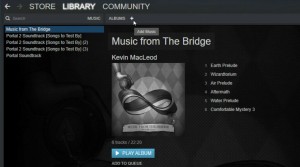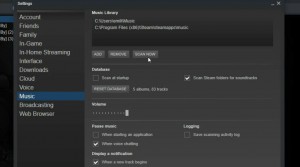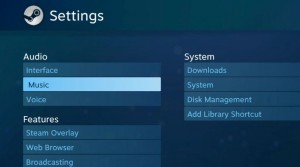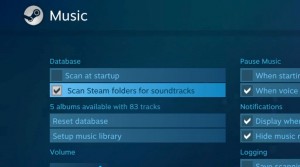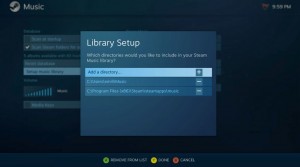UPDATE: Since the introduction of the new Steam Library, your current soundtrack list has been moved. You can find it, and still play your non-Steam albums, by going to the View menu on the Steam client and selecting Music Details.
I’ve always been a fan of videogame music and movie scores, which is why Steam Music is right up my alley. While “regular” people listened to Top 40 hits on their portable cassette players, I was the one kid walking around with a NES’s “greatest hits” compilation or “Best of” film composer mix, taped directly from my console or VCR to my home stereo. The Marios, the Contras, the Bionic Commandos, the Skate or Dies, the OG Ninja Gaidens, the Street Fighters… those tunes run deep in me along with the rest of the classics from my youth.
My “weirdness” was vindicated around the time electronic dance music came into the mainstream, as well as when games replaced their Chiptune-esque melodies for true-to-life instrumental music. So I was ahead of my time and the world eventually caught up with me (cue inspirational orchestra).
This is my long-winded way of saying I’ve loved videogame music before they were cool. So I’m especially grateful to live in a time when game soundtracks not only exist, but can usually be obtained together with the games themselves, without implemented some complicated recording equipment setup or having to tinker around with delicate game file assets.
Valve’s Steam service in particular has done a bang-up job of offering game music as DLC, sometimes free, often cheap. Those downloadable albums may be listened to on any digital player, but Steam supplies these files essentially to be enjoyed with their proprietary Steam Music player. In case you’re unaware, it’s a feature integrated into both the Steam desktop client and Big Picture Mode which, optionally, can also be configured to play your personal music library if you desire (more about that at the end of this article). But what if you already got a soundtrack from a third party, like a bundle site purchase or a free download from the game’s official site? Must you purchase and download it again? What if it’s not available on Steam?
Fear not, for adding additional soundtracks to your Steam Music library is a pretty straightforward process, as it turns out. Just follow these three simple steps and you’ll be up and whistling along in no time. To illustrate this procedure, I’ll be using composer Peter McConnell’s score for Tim Schafer’s point-and-click classic, Grim Fandango Remastered, which is available separate on Steam and together with the Humble Bundle purchase of the game. I’ve also included an abridged video tutorial, which can you watch here.
1. Compile your Music Files Into a “Soundtrack” Folder
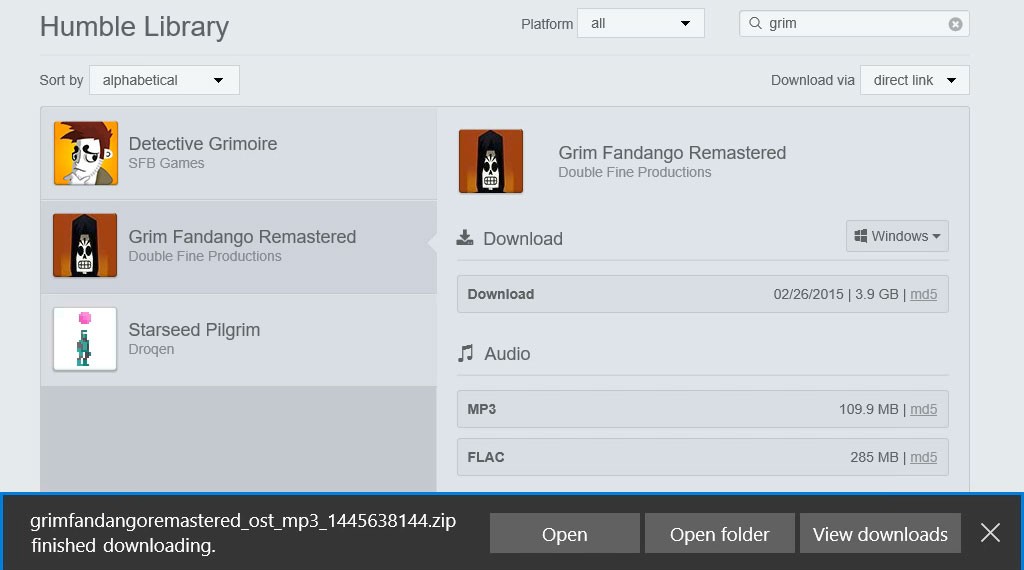
Download and extract the music files from your third-party game purchase service page, or convert your original soundtrack CD to a digital format with an app such as iTunes. It doesn’t matter whether the music files’ format is MP3, AAC M4A or FLAC lossless, since Steam Music reads them all. What does matter is that the name of the folder they’re on is labelled as or contains the words ‘Soundtrack’ or ‘OST’. More on that later.
I’m keeping this one open-ended since download options for different services like Humble Bundle or GOG may vary. Also, I know there may still be a few of you out there who legally own game soundtrack albums on physical CDs. If I go to specifics about how all the ways you can to get your soundtracks, this is going to turn into a book, so let’s keep it practical. The important thing is, if they aren’t giving the music away, it’s better to buy games and soundtracks dirt cheap than to pirate them. Support the game makers and the musicians.
2. Copy your Soundtrack Folder to Your Steam Music or SteamApps Folder
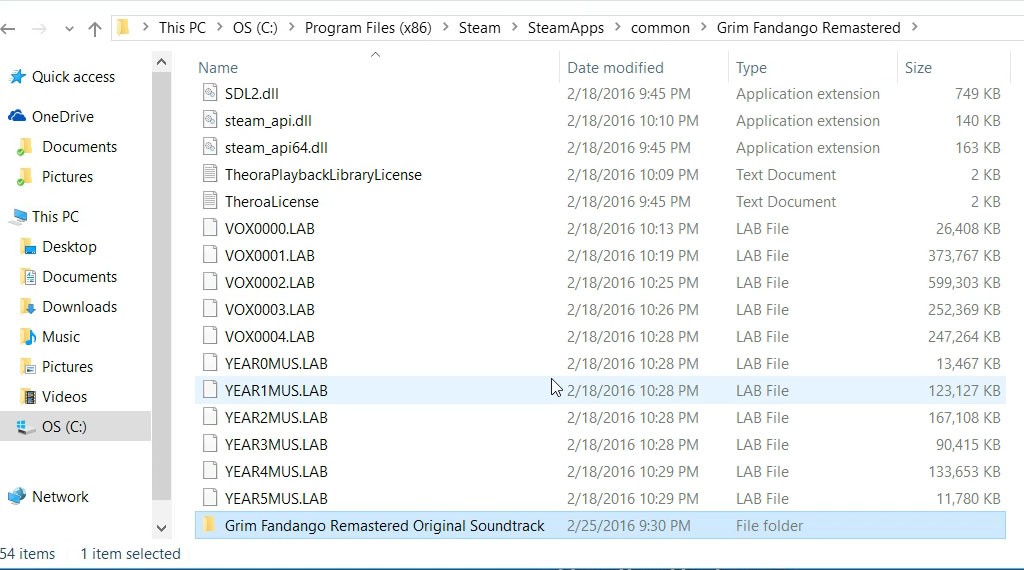
When you download a game soundtrack directly from Steam, it’s usually stored along with the rest of the game’s files in their own folder inside ‘SteamApps => common’. When in desktop mode on your specific Steam device, you may simply copy the soundtrack folder inside its game’s folder there or just anywhere in that directory.
Depending on your device’s OS, you can find location of the SteamApps folder inside your main hard drive in one or more of the following locations (they may be hidden, so you might need to use a Terminal app to find them):
Windows 32-bit
Program Files\Steam\SteamApps\common
Windows 64-bit
Program Files (x86)\Steam\SteamApps\common
Mac OS X
/Library/Application Support/Steam/SteamApps/common
Linux
/home//.steam/steam/steamapps/common
/.local/share/Steam/SteamApps/common
SteamOS
/home//.steam/steamapps/common
/.local/share/Steam/steamapps/common
An easier approach is to find the Steam Music folder and copy your soundtrack folder there. Its location also varies between OSes. Try looking in one or more of the following locations (they may also be hidden):
Windows 32-bit
\Program Files\Steam\Music
Windows 64-bit
\Program Files (x86)\Steam\Music
Mac OS X
/Library/Application Support/Steam/Music
Linux
/home//.steam/steam/music
/.local/share/Steam/music
SteamOS
/home/music
/home//.steam/steam/music
/.local/share/Steam/music
3. Refresh your Steam Music Library
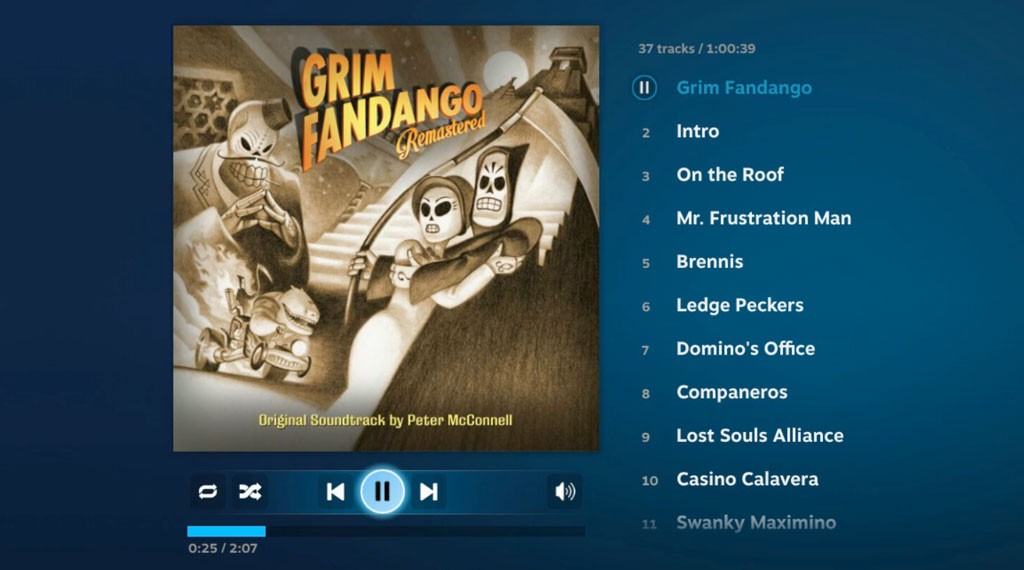
Now that the music files are in place, all that’s left is for Steam to find them. How to do this depends on whether you use the Steam desktop client, SteamOS or Big Picture Mode.
Steam client: Select Music in your Library window and click on the plus sign (+) beside the Albums tab. Alternatively, select Settings in the Steam drop-down menu at the top and choose Music in the left column.
SteamOS/Big Picture: Select the Settings icon at the top and choose Music under the Audio list.
Any of those approaches will take you to the Music Settings window. Once there, make sure the ‘Scan Steam folders for soundtracks’ box is checked. Then, if on the Steam client, click the Scan Now button. If in SteamOS or Big Picture Mode, press the ‘Setup music library’ button and select ‘Done’.
Steam will proceed to scan your folders, and voila! You should find your new albums included in the soundtrack list inside your ‘Library => Music’ window. Press play and enjoy!
UPDATE: Since the introduction of the new Steam Library, your current soundtrack list has been moved. You can find it, and still play your non-Steam albums, by going to the View menu on the Steam client and selecting Music Details.
Was your soundtrack not detected? Did you make sure to include ‘Soundtrack’ or ‘OST’ in the folder name as stated in Step 1? Steam Music won’t detect your album if you didn’t, unless it’s on an external music library folder and you link that folder to Steam in Music Settings (see below). If your folder is properly labeled but Steam still can’t find your music, check to see if your files are corrupt and try re-downloading or ripping them again from your CD.
Closing Thoughts

You may also add any personal music folder inside your hard drive for Steam Music to play it. Just click on the ‘Add’ button in Music Settings and browse to the location of your Music directory. But for game soundtracks, this procedure is cleaner and more akin to how Steam itself manages its music.
If you download soundtracks often, you can simplify Step 3 of this tutorial by checking ‘Scan at startup’ in Music Settings. This will make Steam scan for both old and new items every time you turn on your machine without you having to scan manually every time, as well as check any personal music library folders you added to find new albums. The only downside is that it may slow down Steam boot-up depending on the total size of your soundtrack or personal music library.
Although maybe not yet essential to music fans and gamers, Steam Music is a nice feature that exists because machines with SteamOS, as well as desktop PCs on Steam Big Picture Mode, are meant to be connected to your flat-screen TV and treated as consoles. Like a PS4 and an XBox One, with just as many entertainment options available. The player still has some kinks in my opinion, such as the lack of gapless play between tracks, but it has a future as part of an all-in-one living room entertainment center.



